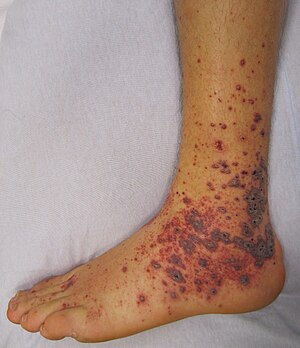Petechia
| Petechia | |
|---|---|
 |
|
| Petechia and purpura on the low limb due to medication-induced vasculitis | |
| Pronunciation | petechia /pᵻˈtiːkiə/ petechiae /pᵻˈtiːkiiː/ |
| Classification and external resources | |
| Specialty | Rheumatology |
| ICD-10 | R23.3 |
| ICD-9-CM | 782.7 |
| MeSH | D011693 |
A petechia, plural petechiae, is a small (1–2 mm) red or purple spot on the skin, caused by a minor bleed from broken capillary blood vessels.
Petechia refers to one of the three descriptive types of bleeding into the skin differentiated by size, the other two being purpura and ecchymosis. Petechiae are by definition less than 3 mm.
The term is almost always used in the plural, since a single lesion is seldom noticed or significant.
The most common cause of petechiae is through physical trauma such as a hard bout of coughing, holding breath, vomiting or crying, which can result in facial petechiae, especially around the eyes. Petechiae in this instance are harmless and usually disappear within a few days.
Petechiae may also occur when excessive pressure is applied to tissue (e.g., when a tourniquet is applied to an extremity or with excessive coughing or vomiting).
Sunburn, childbirth, weightlifting.
Gua Sha is a Chinese treatment that scrapes the skin
Petechiae may be a sign of thrombocytopenia (low platelet counts) when platelet function is inhibited (e.g., as a side effect of medications or during certain infections), or in clotting factor deficiencies.
Childhood protein-energy malnutrition such as Kwashiorkor or Marasmus
If unsure, petechiae should always be quickly investigated. They can be interpreted as vasculitis, an inflammation of the blood vessels, which requires immediate treatment to prevent permanent damage. Some malignancies can also cause petechiae to appear. Petechiae should be investigated by a doctor to rule out the more dangerous conditions.
The significance of petechiae in children depends on the clinical context in which they arise. Petechiae in children can occur with viral infections. In this instance, they do not necessarily signify a serious illness. However, they are a hallmark signal of some potentially serious illnesses, such as meningococcemia, leukemia, and certain causes of thrombocytopenia, of which meningococcemia can cause death within 48 hours of infection. Therefore, their presence should not be ignored.
...
Wikipedia
